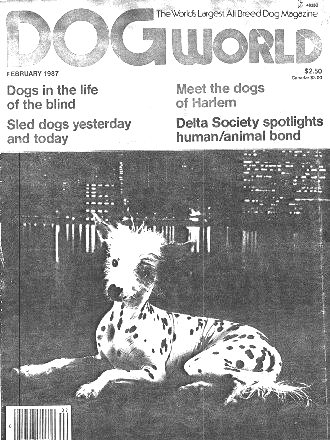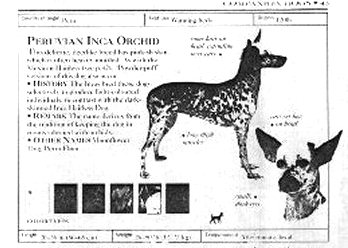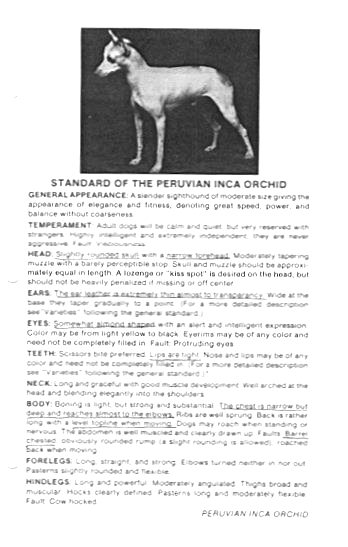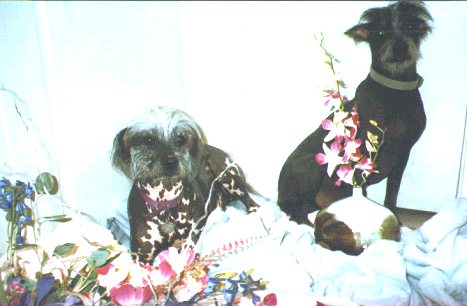Links to:
HomeXolo
Mexican Hairless
pila dog
Normal?
Coated
The gene
Ancient dogs
Elephant Dog
PIO
Genetic Registry
Contact
Genetic Registry for Hairless Dogs
Ancient dogs and PIO |
Other Ancient Hairless Types
'Enigma' lists several types of dogs that are rumored to be hairless, but have few hard facts to support some of the claims.
The most notable is the Tepeitzcuintle. The photo of this 'extinct' breed shows two light skinned hairless with light hair on top of the head, white or light blond. Why would they think this type is extinct when we have similar looking dogs in Xolo litters?
It is my belief that these dogs had recessive hairlessness. The head hair that is today associated with dominant hairlessness, may have been linked from the random working of genes over the eons.
There are several things that support this assumption.
First, one of the best ways to produce offspring that are not to type is to breed to a short white or blond haired dog. Doing so is a break in the pattern. While fluffy blond/red hair is a pila mix that can be predicted, and long unfluffy hair is a pila type that will conform to Xolo rules, the random results of the short white/blond hair not red tipped, is a different pattern.
It may be that short red hair without other pila traits conform to Xolos rules, it has not been proven and I have a few litters planned to test this hypothesis.
Years ago we Xolo owners dismissed the statement of Fra. Saguin that they rubbed oil on puppies with hair, then it fell out and they stayed hairless - this was nonsense from everything we knew.
Then I studied the AHT and recognized some of the recessive traits in pila/xolos, and I looked up the actual quotation of this man. It continued '...but they say that in other villages dogs are born without hair.'
This confirms that when the Spanish arrived, there were two types of hairless litters in Mexico, and that the type in the center of the Aztec Empire was the recessive type.
It is likely that this type was the Tepeitzcuintli, and that what is left of it has been blended into the mix of hairless dogs and is no longer distinct. If someone want to attempt to strain out the genes for this type I will be glad to help you plan to do so. It would mean taking all the short white haired dogs from xolo/pila litters and breeding them separately for 2 or 3 generations, and carefully keeping out a few pila traits.

Elephant Dog
The Elephant Dog was a name given to the heavy bodied, short tailed pila from Peru.
These dogs have thicker, rougher skin that is gray instead of true black. Some are very hairless and have large long ears that amazingly do go up in time, but when one gets a pup they do hang down like elephants.

Peruvian Inca Orchid
Most Central and South American countries do not distinguish between hairless breeds.
In Peru in the 1980's, there was one registration allotted for hairless dogs and several breeds were registered in it, Chinese Crested, Xolos and PIO's. The owners knew which were which, but there was no way for an outsider to know.
In this way Peruvian registered Chinese Crested, and Xolos have been accepted as PIO's in the USA, which is why in the late 1980's PIO's were of all sizes and descriptions. It didn't help when the American Hairless Dog Club folded without the information in the database being available to owners.
The PIO if the 1980's was usually a large dog with long light colored hair on the head and many spots.
The PIO of today are the very hairless dark skinned type of pila, and do not match the standards for PIO of past decades. It is not my business to tell anyone what their breed should be, but it is hoped, that owners will not let their dogs die out in a dedication to a standard that is at best transitory.
Below is a PIO puppy featured on the cover of Dog World in the late 1980's.



The dog on the cover of Dog World was Keko, and in the 90's I provided her with a mate. Here is their wedding picture.

You can see that the older Keko showed her heritage as coming from the fuzzy faced pila better than she did as a puppy. In fact, I had to compare the patterns of spots before i would accept that it was the same dog.
Today her daughter is ready for a litter, and we have chosen a great mate for her. We hope to have puppies this year. But no matter how great her litter is, the pups can not be registered in any PIO registry in the United States.
For this reason, and for many other dogs who have been assigned to a too general breed name for their type or have been eliminated from registration by arbitrary rules; and for people who want to have the option of a duel registry, with consideration to the historical type of the breed rather than the ever changing standard in vogue and the possible damaging to the gene pool, we have created:
The Genetic Registry!
Next
The Genetic Registry!
Next